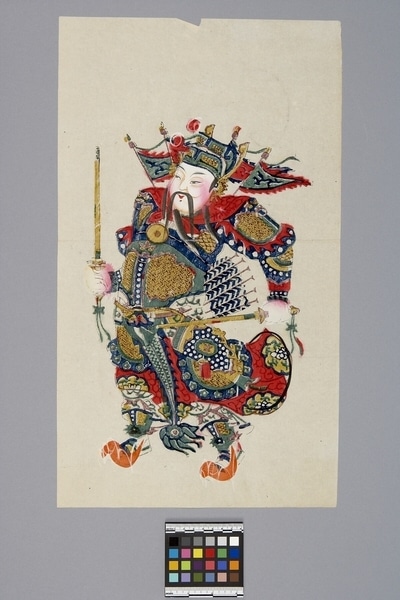Door God Print Item Number: 1090/12 from the MOA: University of British Columbia

Description
Depicted is a military door god (wu menshen; 武门神) named Qin Qiong (秦琼). He has a white and pink face, red mouth, a small black goatee, long black moustache, and a black beard in strands. White and pink hands are holding a sword each with his right hand holding the sword upward while his left hand is holding the sword outward horizontally. Wearing clothing that is yellow, blue, green, and red with orange shoes. Six blue-feathered arrows that have purple shafts are behind him. Figure is standing at a slight angle facing to the left side. Background is simply the plain paper. The print is vertically rectangular.
History Of Use
Known as menshen (门神, door gods), they are considered to protect homes from evil spirits. Prints depicting them are usually displayed on the door inside and outside the house during the Chinese Spring Festival (春节) or Lunar New Year. Such prints are thus known as nianhua (年画, new year pictures). Military door gods would be displayed on the external doors of the home.
Cultural Context
Military door god Qin Qiong (秦琼), often paired with another door god Yuchi Gong (尉迟恭) are the generals of the Tang Dynasty emperor emperor Tang Taizong (唐太宗). These generals are popular representations of military door gods, and their looks are usually contrasting. Yuchi Gong (尉迟恭) who usually appears on the left side, looks fierce as compared to Qin Qiong (秦琼), who usually appears on the right side as a pair. They face each other to prevent spirits from passing through the doors. Nianhua (年画, new year pictures) are usually printed on plain backgrounds, but some prints from Yangliuqing (杨柳青), known for the production of nianhua have background designs with patterns. The Yangliuqing style is known for finishing details, especially on the face.
Narrative
This print is paired with another print (1090/1) and together, they are called Military Door Gods Qin Qiong and Yuchi Gong (秦琼 尉迟恭). This set of prints (1090/1-13) was collected by Abbie Lyon Sharman, the sister of the donor’s grandmother, Sophia Lyon Fahs.
Item History
- Made in Yangliuqing, Tianjin, China during 1920
- Collected during 1920
- Owned by Brenda Beck before December 20, 1985
- Received from Brenda Beck (Donor) on December 20, 1985
What
- Name
- Door God Print
- Identification Number
- 1090/12
- Type of Item
- Overall
- height 51.6 cm, width 29.8 cm, depth 0.1 cm
Who
- Culture
- Chinese
- Previous Owner
- Brenda Beck
- Received from
- Brenda Beck (Donor)
Where
- Holding Institution
- MOA: University of British Columbia
- Made in
- Yangliuqing, Tianjin, China
When
- Creation Date
- during 1920
- Collection Date
- during 1920
- Ownership Date
- before December 20, 1985
- Acquisition Date
- on December 20, 1985
Other
- Item Classes
- works on paper
- Condition
- good
- Accession Number
- 1090/0012